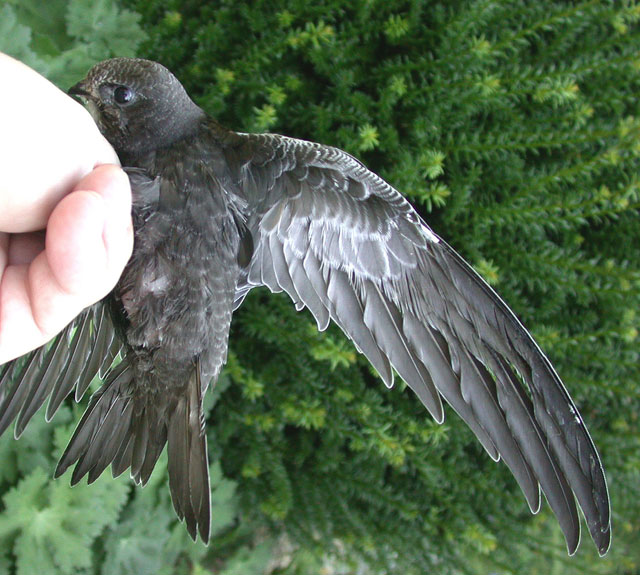
Common Swift: Sheffield, July 2006 Meet Charlie, our houseguest during July 2006. All juvenile Common Swifts in fresh plumage have pale 'scaling' to varying degrees, produced by pale fringes to the feathers of the body and wings. His tail is similarly proportioned to that of a Pallid Swift (photo: Martin Garner).
Finding Charlie
The "Devil Bird" is one of the local, rather rustic, colloquialisms by which the Common Swift is sometimes known in Britain. It is not surprising. One of the most familiar views of these birds is the sight of them screaming through the sky like minute black kamikaze fighter aircraft.
Sharon, my wife, is a primary school teacher. Her school building hosts a colony of Common Swifts each summer. Normally the birds are seen high in the sky, wheeling and screaming, as they call and display and repeatedly visit their colony under the eaves. However, the summer of 2006 proved a little bit different and had quite an impact upon our family. It started in early July, when a young swift, which had fallen out of the nest, was found in the schoolyard. Sharon seems to be endowed with the spirit of St. Francis of Assisi, so she immediately volunteered to bring the young bird home to see if we could help it to recuperate. My response was simple. I felt it had no chance as the colony was unreachable, and I knew the adult birds would not be able to feed it on the ground. So my expectation was for the young bird to die overnight in a cardboard box in our shed. However, this little critter was a survivor. So began the five weeks of learning how to feed, and rear, a juvenile swift that was quickly christened 'Charlie' by my daughters, Emily and Abigail. In the end our care regime amounted to five daily feeds, which took in the addition of two more juvenile swifts, which also fell from the colony, and a 24-hour stay for one of the adults that flew into a classroom window.
In one of those serendipitous connections, Sharon was investigating how to feed the swifts and decided to visit the local fishing tackle shop. The proprietor could offer no advice apart from to ring his friend, who he claimed kept swifts in an aviary in his back garden. I very much doubted this so decided to ring the guy anyway, only to discover that it wasn't swifts he kept but several pairs of Siberian Thrushes!
The lifestyle of swifts is one that draws curiosity. Their ability to leave the nest as juveniles, and then possibly not land for up to two years, is the kind of fact that goes alongside the epic migrations of Arctic Terns, and navigational skills of Manx Shearwaters.
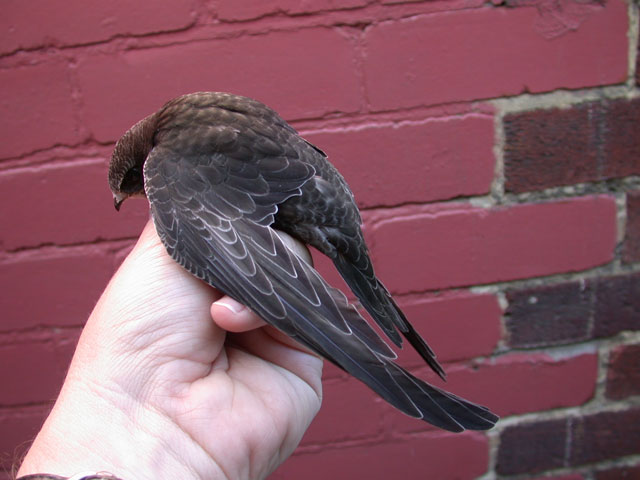
Common Swift: Sheffield, July 2006 Charlie shows his colours...Here I just turned his body to catch some rays of sunlight and was really surprised at the way the light on the feathers produced this paler, and much browner, appearance. Just notice also how scaly and brown juvenile Common Swift can look! (photo: Martin Garner).
I have been interested in the identification of swifts for some time, particularly the struggle involved in separating Pallid Swift from Common Swift, as well as the various races of both species. Summer 2006 gave me an unparalleled opportunity to learn more about the plumages of adult and juvenile Common Swifts. I was also in Turkey in May 2006 comparing both Pallid and Common Swifts and found myself once again scratching my head. As the end of October draws near, there is now an annual expectation that a small pulse of Pallid Swift will appear in Britain, often along the east coast. It would seem, however, that the identification of these birds still remains one of the most difficult challenges in the British Isles.
The complex nature of swift identification
I love trying to make complicated things simpler. The main reason being so that I can understand them better! Unfortunately with swifts this is just not possible. In fact the identification of Pallid Swift is, I think, generally considered to be more straightforward than it really is. The first British record was found in May 1978 in Kent and one of the finders, Bill Harvey, went on to enumerate a number of characteristics by which Pallid Swifts could be identified. This checklist of characters has become the main basis for separating Pallid and Common Swift in a vagrant context. In the process of researching swift identification in recent months I have come to a number of conclusions about the complexity of swift identification. More recently I decided to read through Bill Harvey's account. I wish I had read it earlier! Many of my misgivings about the ease of swift identification are clearly spelt out in his account. Indeed, it could be argued that this first account still provides an excellent grid through which descriptions of potential vagrant Pallid Swifts could be passed. So in respect of the work that has already been done I'm going to quote directly from Harvey's paper.
"The unusually favourable circumstances of this sighting should not obscure at all the difficulty of separating Pallid Swifts from Swifts in the field. Light conditions have a variable effect on the apparent colouration, since the differences are largely matters of degrees of shade. Wind conditions affect the mode of flight. Young Swifts are often paler than adults, show a more extensive pale throat patch and some mottling or scaling. There is also the possibility of unusual plumage variants and leucistic Swifts may be particularly misleading (e.g. Vinicombe 1978).
The Central Asian race of the Swift A. a. pekinensis is intermediate in coloration between the nominate race of Swift and the darker races of the Pallid Swift. It has a larger throat patch than the nominate race and may show pale tips to the breast and belly feathers. Its primaries are darker than its secondaries. In an examination of skins at Tring, Robert Hudson could find no single plumage character which consistently separated all pekinensis from all Pallid Swifts. Since this subspecies ranges west to Turkey and the Levant its occurrence in Western Europe is possible, and it is necessary to exclude it in the field identification of suspected vagrant Pallid Swifts."
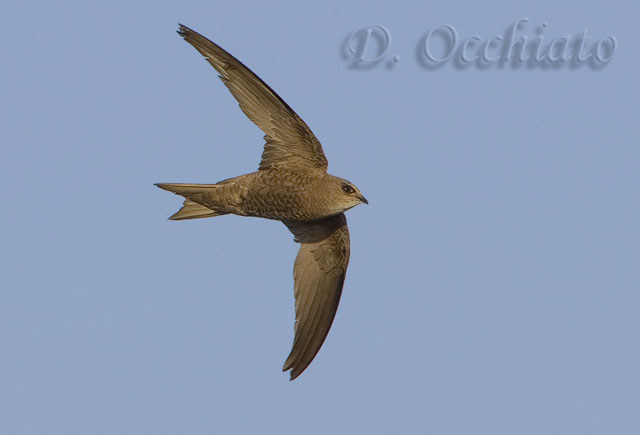
Adult Pallid Swift: Spain, August 2006 Overall the plumage is a rather worn pale sandy colour with no strong contrast about the face and pale, but obvious, scaly appearance on the underbody. The latter is due to a paler ground colour to the feathers and darker subterminal crescents. The pale/whitish fringes have worn off. None of the other swift plumages are ever really this pale brown colour overall. This individual is moulting inner primaries and outer secondaries, which is indicative of adults at this time of year; They seem to moult earlier than Common Swifts, though there is much to learn about moult in Swifts (photo: Daniele Occhiato).
On reviewing the photographs and description of the 1978 bird, I wonder if this individual is actually a first-summer Pallid Swift. Although information on the moult of Pallid Swifts is limited it would appear that first-summers might undergo a partial post-juvenile moult so that they would essentially retain the worn juvenile wings. The 1978 bird was a strikingly pale individual and had distinct pale fringes to the upper- and underwing coverts. There was very strong contrast on the underside, between the dark body and pale in the wing. This would be consistent with a bird which had moulted its body feathers but had retained worn, and paler, flight feathers. At best, even if it is not possible to age as accurately as I am suggesting, the 1978 bird perhaps provides data on separating (first-summer?) Pallid Swifts from Common Swifts in May and June. However, it does not deal with the problem of juvenile Common Swifts which appear later in the summer. The key characters drawn from the first British record in 1978 should not be used as the main basis for identifying any vagrant swifts in the autumn.
Here I will attempt to review some of the main characteristics for identification of Common and Pallid Swifts, including the various races. I will do this according to the seasons. This will help to focus on the particular characteristics that are useful at these times.
Identifying swifts in spring and summer
Obviously during these seasons the main plumages are chiefly adult-like (including first-summers, which can have faint vestiges of juvenile plumage about the wings and may be more worn and pale). The main issues which complicate swift identification during this season is the potential presence of adult Asian Common Swifts ssp. pekinensis and the possibility of overlooking the darker form of Pallid Swift from the central Mediterranean (ssp. illyricus).
Common Swift
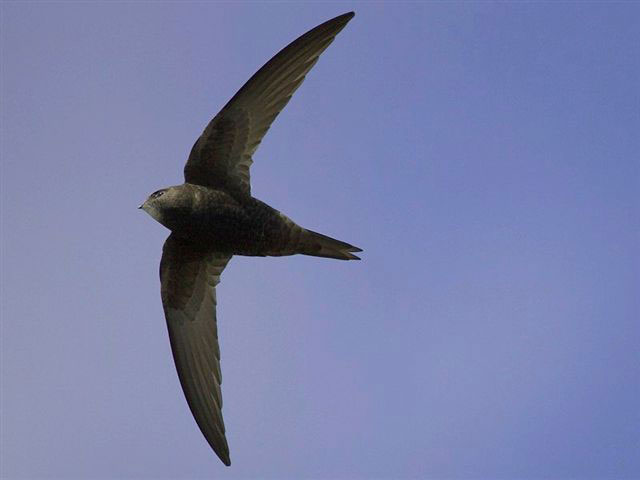
Adult Common Swift: Finland, May Even adult Common Swifts can show a scaly effect below. However, no other swift in this group has a plumage type in which there is such a small, confined, pale throat patch and such relatively uniform dark plumage (photo: Tom Lindroos).
Nominate-race birds are generally straightforward to identify due to their relatively uniform blackish-brown plumage. The only pale area is to be found in a small isolated off-white throat patch, and even that can be difficult to see in the field. The rather long tail, with relatively deep tail-fork, and long and narrow wings all add weight to the "Devil Bird" moniker. One of the subtle structural differences between adult Common and Pallid Swifts is to do with the caudal projection (the 'bit' of the body and tail beyond the wings). In a nutshell the body section between the wing base and start of the tail on the Common Swift appears short, and the length of the tail is clearly longer. Of course this is hard to discern in the field, but is more easily seen in photographs of the birds in profile, with tail slightly spread. I think this difference in the tail and body proportions at the rear end adds something to the distinctive 'jizz' of Pallid and Common Swift, though I have not finished exploring the subject!
Pallid Swift
Bill Harvey's characteristics drawn from the 1978 record still serve well for identifying birds at this season and are repeated here. Though I repeat that I believe the paleness, and degree of contrast, may be heightened by the possibility of the 1978 bird being a first-summer. The caudal projection, structure, including obviously longer tail as well as deep tail fork of Common Swift, can help in identification. Pallid Swifts do have a more disyllabic call when you hear them on the breeding grounds, though I don't know of any evidence yet that suggests this could be useful in identifying vagrants.
A checklist of features for separating Pallid Swifts at this time include:
- Paler milky brown plumage.
- Dark brown outer primaries contrasting with the paler secondaries and wing-coverts.
- Breast, belly, and especially mantle, appearing darker than wing-coverts, head and rump. The dark mantle can create a 'saddle effect' and seems to be a consistent feature independent of light conditions, whereas the dark underparts may only be a factor of shadow.
- Pale whitish throat extending further down the breast to the sides of the neck and onto the forehead.
- Distinct 'scaliness' on contour feathers, most noticeably on the wing-coverts and flanks.
- Dark shadow mark around the eye, often clearly showing on pale head. Although a factor of light conditions this can be a striking field mark.
- The blade-shaped wings are broader-based and usually with blunter wingtips. Less obviously, the tail points look blunter and the fork shallower.
- Less agile, more deliberate flight, with more gliding.
Asian Common Swift ssp. pekinensis
This form breeds considerably nearer than other vagrant Asian swifts (such as White throated Needletail and Pacific Swift), which have occurred in the spring to summer period in Britain. In my opinion they are a very likely potential vagrant and could easily be misidentified as Pallid Swifts. Based on a study of specimens, and photographs, as well as distantly viewed birds in East Africa, the body plumage-tone is paler than Common Swifts and slightly darker than most Pallid Swifts. They do, however, have a large pale throat patch, which can be as extensive as typical Pallid Swift. They have strong contrast in the upperwing pattern, which is very similar to Pallid Swifts. They also tend to have a more obvious scaly pattern than nominate Common Swift below, which can recall Pallid Swift. If I were looking to claim an Asian Common Swift in Britain in the summer, I guess I would be looking for a paler-brown Pallid Swift 'scare' but with the same long tail and shorter rump-side section as Common Swift. Confusingly though it would be contrastingly pale and dark in the upper-wing. So I would especially focus on the head pattern to try and nail it.
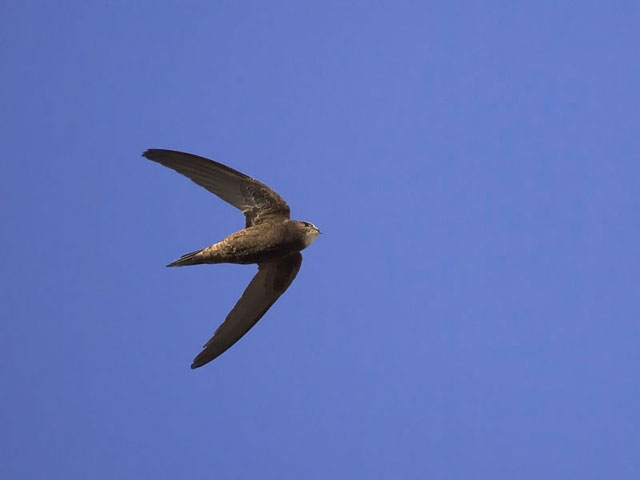
Asian Common Swift: Kyrgyzstan, July Not looking quite as pale as many Pallid Swifts in the summer. Nevertheless the scaly effect on the body, rather medium brown body plumage, and big pale throat patch all invite confusion with Pallid Swift. Notice too how blunt-winged this bird appears in this photo (photo: Tom Lindroos).
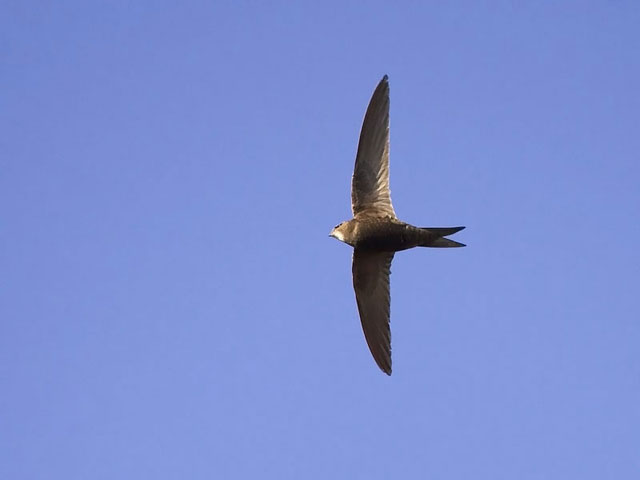
Asian Common Swift: Kyrgyzstan, July The slightly opened tail looks too long (and in comparison to the overall caudal projection), with too deep a tail-fork for Pallid Swift. However, notice also how the dark eye-patch seems to 'stand out' in a rather pale brownish head and the body plumage is 'scaly' (photo: Tom Lindroos).
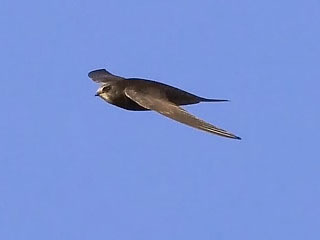
Asian Common Swift: Kyrgyzstan, July This shot looks more like a normal Common Swift in summer...except for the clear white forehead patch which is a diagnostic difference from nominate adult birds in summer. Pallid Swift also doesn't normally show such a distinctly marked-out white forehead in adult summer plumage (photo: Tom Lindroos).
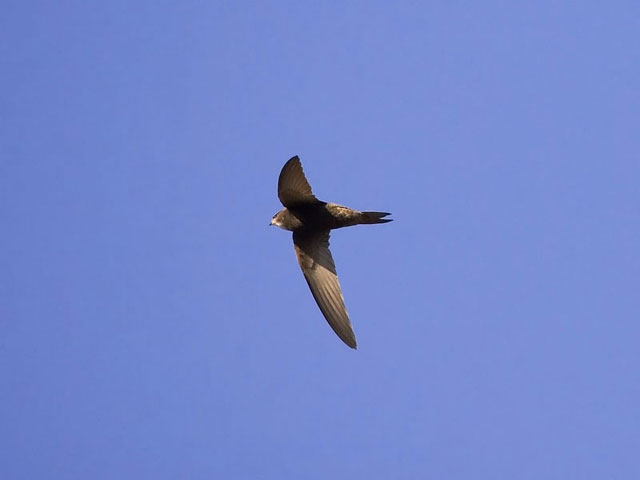
Asian Common Swift: Kyrgyzstan, July Adult (photo: Tom Lindroos).
However, there is one particular character I would especially look for in adult Asian Common Swifts in early/mid-summer: a very white forehead that is neatly demarcated from a darker-brown crown. Adult Common Swifts of the nominate race have all-dark foreheads and Pallid Swifts tend to be rather sandy, or mouse-brown, over most of the upperparts. The forehead area can be paler in Pallid Swift but it is diffuse and not so strikingly white. The bright white forehead patch of Asian Common Swifts in adult (summer) plumage seems to be unique to them.
Pallid Swift spp. illyricus
The central Mediterranean (of eastern Adriatic, and perhaps western Adriatic also) form of Pallid Swift has already occurred in northern Europe in the early spring. An individual was found dead in Denmark in March 1993. It was collected and identified as a Common Swift, and it was only when Kasper Thorup was looking through a museum collection that he found this individual and realised it was a Pallid Swift of the subspecies illyricus. The basic characteristics of this form are similar to those of other Pallid Swifts; however, the overall body plumage is much darker. Thorup describes illyricus as having only slightly paler body plumage than that of nominate Common Swift. The dark eye-surround contrasts less than in other Pallid Swifts and the pale feather fringing on the breast and belly feathers is less obvious. There is less contrast in the wing between the paler greater coverts and secondaries and the dark back. Thus, illyricus Pallid Swift is an altogether more subtly plumaged Pallid Swift that might easily get overlooked as an early Common Swift in the spring.
One feature, which Thorup noted as possibly being unique to ssp. illyricus, is the presence of very pale underwing coverts. These contrast significantly with the darker underside of the body and the flight feathers. He noted that in the other subspecies of Pallid and Common Swifts there was less contrast. It would clearly be worth double-checking any swifts that are seen prior to the main arrival times. Even if the individual is not particularly pale-looking, serious consideration should be given to this dark race of Pallid Swift. Check such features as structure, flight action, pale fringing to the body plumage and contrasts in the underwing.
Identifying swifts in the late summer (i.e. July and August)
It is interesting to note the occasional reports of Pallid Swifts in late July and early August, especially the kind of report that runs something like "One Pallid Swift seen flying with another unidentified swift." This is exactly the time when juvenile Common Swifts leave the nest. They can occasionally be seen in the company of adults where their plumage, and even their structure, can be strikingly different. I suspect that a number of claims of Pallid Swift during this season actually refer to juvenile Common Swifts. Even adults can be somewhat of a challenge in that the plumage is at its most worn, being paler brown than in May/June with more contrast particularly in the wings, which produces a poor mimic of the Pallid Swift pattern.
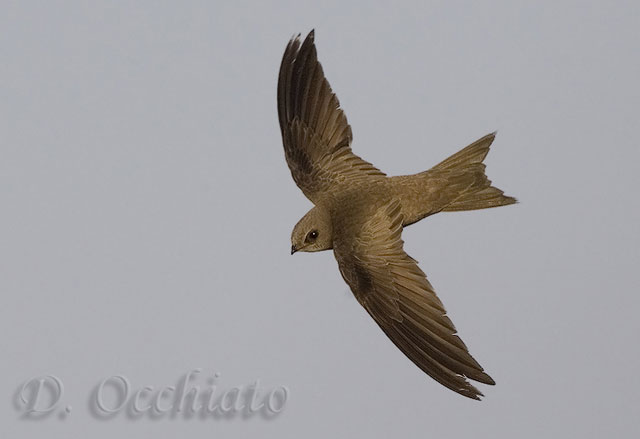
Adult Pallid Swift: Spain, August 2006 This is in the palest and most worn plumage. Notice how adult Pallid Swifts in late summer are essentially rather uniformly pale sandy-coloured swifts. The forehead is not strikingly white and contrast in the upperparts and wings, while present, is sometimes over-emphasised in descriptions of Pallid Swift. Juveniles are much scalier looking above with more obviously paler foreheads (photo: Daniele Occhiato).
The problem with juveniles arises because they leave the nest and, in most cases, migrate almost immediately. They can be in Spain or North Africa within four days of leaving their British colony. This means that the plumage of juvenile Common Swift is considerably less familiar to many British birdwatchers. Neither is it particularly well illustrated in some of the leading field guides, not even being represented in the Collins Bird Guide. Juvenile Common Swifts are slightly variable, but can often be paler in overall plumage tone than adults, with a paler-looking rump and slightly darker mantle. The whole body, apart from mantle and scapulars, can be pale fringed and scaly, though not as strikingly scaly looking as on Pallid Swifts. They have a larger white throat patch than adults and obvious white lores and forehead, extending diffusely over the crown as whitish fringes to the crown feathers. With so much whitish in the forward part of the head the dark eye patch is much more conspicuous than on adult Common Swift, thus recalling Pallid Swift. The shorter tail structure of juvenile Common Swifts is virtually identical to that of many Pallid Swifts. Typically, I find the most helpful feature is that the white throat patch is still smaller, and more neatly demarcated, than typical Pallid Swift. With careful observation the overall plumage is still essentially blackish, or dark brown-looking, and the white feather fringes contrast strongly with dark feather centres.
Identifying swifts in the autumn (i.e. September to November)
The presence of both juvenile Common Swifts, and the potential presence of Asian Common Swifts during this season, is clearly a problem when it comes to identifying vagrant Pallid Swifts. Indeed, I find the whole subject more and more of a conundrum. Probably the first helpful starting point is to attempt to age any interesting swift. This in itself is a challenge. There are likely to be claims, or even accepted records, of Pallid Swifts in Britain that have not been seen well enough to establish the age of the individual. All adults at this time of year will still be in primary moult and are likely to appear rather worn. Juveniles on the other hand will have a complete fresh set of flight feathers, with obvious pale fringing on most of the wing and tail feathers. It would seem reasonable that most swifts occurring during the crucial October to early November season are likely to be juveniles.
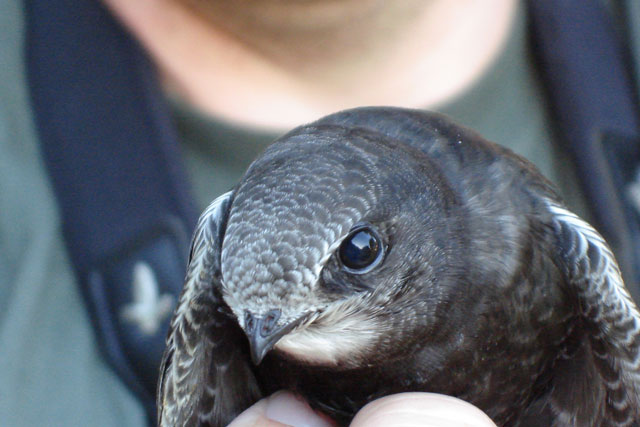
Common Swift: Sheffield, July 2006 Close-up of Charlie's head showing the degree of paleness which is much greater in juvenile than in adult Common Swifts (photo: Paul Hackett).
During this season it is mostly juveniles that are involved. I would argue that there are almost no diagnostic characters, but merely a set of differences of degree. In fact as I looked through some excellent photographs of claimed Pallid Swifts taken in northern Europe in recent years I asked myself the question: "Why then is this a Pallid Swift and not an Asian Common Swift." Not only did I find it difficult to answer in some cases, but also I actually began to believe that the bird in a given photograph might indeed be an Asian Common Swift, which has probably been accepted as a Pallid Swift. In other cases it appeared that the photograph of a claimed Pallid Swift appeared to be a juvenile Common Swift of the nominate race. Perhaps the best way to claim the vagrant Pallid Swift might be to see it badly, and briefly, and not to get any good photographs!
To demonstrate how the subject is a little more complicated than generally perceived let's take the pale throat patch character for example. In nominate Common Swift the juveniles average slightly paler in body plumage than the adults with a clearly larger white throat patch, as well as an obvious area of white on the forehead, which is lacking in adults. Asian Common Swift differs in that the juveniles, while having slightly paler body plumage than the adults, have a smaller white throat patch on average, but also have even more white on the forehead than nominate race juvenile Common Swifts.
Pallid Swift differs again in that, like Asian Common Swift, the throat patch may be slightly smaller than in adults and perhaps slightly more demarcated with more of an obvious pale area on the forehead. However, the white on the throat and forehead of Pallid Swift is less bright white, less contrasting, and less striking than in juveniles of both races of the Common Swift. Confused? I think part of the problem is that awareness of the appearance of these swifts in juvenile plumage is still in its infancy. For example, it is as yet unknown whether Pallid Swifts undergo moult of their flight feathers prior to their first breeding season, or not (see BWP).
So here is a tentative attempt at features to look for in separating these swifts in juvenile plumage in late autumn. There are structural differences between Pallid and Common Swifts, but they are considerably reduced; juveniles have similar tail dimensions. In all three swifts considered here it is difficult to know how much emphasis to give to the slightly broader wings, slightly broader body and marginally slower flight action. These features, which are usually attributed to Pallid Swifts, are arguably only really useful if a particular individual is in direct comparison with other swifts of a different form, or species. The oft-quoted blunter wing-tips of Pallid Swift are sometimes attributed to differences in lengths of the outer primaries, relative to one another, between Pallid and Common Swift. In fact there is complete overlap in this character. I think there is much to learn!
Nominate Common Swift — juvenile plumage
While in juvenile plumage Common Swifts have many pseudo-Pallid Swift characters. They still remain rather darker overall in appearance, and especially tend to have a strong contrast with white on the forehead, throat, and feather fringes being bright and sharply demarcated. One feature that juveniles of the nominate race do not have is conspicuous pale (whitish) fringing of the feathers on the mantle and scapulars.
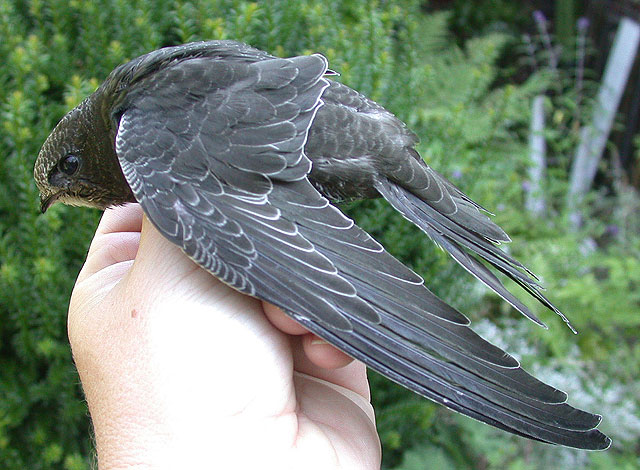
Juvenile Common Swift: Sheffield, July 2006 'Charlie' again, showing the rather typical plumage tones and scaly effect of juvenile Common Swifts of the nominate form (photo: Paul Hackett).
Asian Common Swift ssp. pekinensis — juvenile plumage
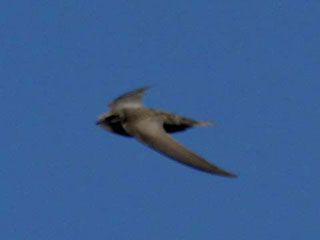
Asian Common Swift: S. Africa, January Look at the very Pallid-like appearance of this Asian Common Swift. Identity here is essentially based on location: This is the normal winter range of Asian Common Swift and there is only one record from South Africa of Pallid Swift. The plumage characters match the expected appearance of Asian Common Swifts based on specimens. The challenge of elimating ssp pekinensis when claiming vagrant Pallid in the autumn has been vastly underestimated (photo: Dick Newell).
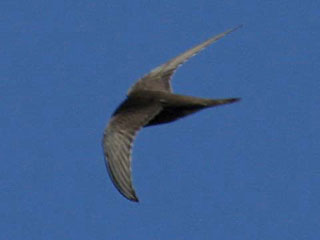
Asian Common Swift: S. Africa, January The body looks a little too dark for Pallid Swift, though assessing the particular plumage tones of any individual swift in flight can be a nightmare in differing light conditions. The wings are contrastingly pale looking and quite extensively so (photo: Dick Newell).
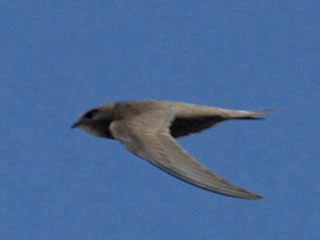
Asian Common Swift: S. Africa, January Notice how the overall appearance of this bird is very like a Pallid Swift here. Perhaps only the rather well demarcated pale throat patch might attract attention as being a little too clearly demarcated from surrounding darker plumage for Pallid (photo: Dick Newell).
Asian Common Swifts in juvenile plumage seem to show many of the same characteristics as Pallid Swift. The overall plumage is slightly darker, but the difference is one of degree, and there does not seem to be a single diagnostic character. Unlike juveniles of the nominate race, juvenile Asian Common Swifts do have whitish fringes to the mantle and scapulars similar to juvenile Pallid Swifts.
Pallid Swift — juvenile plumage
Pallid Swifts in juvenile plumage may be slightly darker than adults in summer plumage. This is the converse of the other two swifts being looked at here, in which their juvenile plumage is slightly paler than the corresponding worn adult summer plumage. The classic Pallid Swift, seen well, is still paler and more sandy-toned overall than any other swift plumage covered here. There is more contrast in the flight feathers and a more conspicuous dark eye-mark than in the juvenile Common Swifts of either the nominate form or ssp. pekinenis. However, the difference is only one of degree, whose correct assessment is largely dependent on ideal light and viewing conditions There does not seem to be a single diagnostic character. Hopefully, further study, particularly of Pallid Swifts and Asian Common Swifts in juvenile plumage, will help clarify our efforts at identifying vagrant swifts in the autumn.
In summary
The appearance of swifts in the field can vary enormously even on a single bird. They are amongst the most mobile birds on the British list, and therefore the most difficult on which to see cryptic identification features. Also, despite comments following previous records, there is still a lack of awareness of the appearance of juvenile Common Swifts and the distinct possibility of the presence of Asian Common Swifts masquerading as vagrant Pallid Swifts.
More than ever, claims of Pallid Swift need to be seen exceptionally well with all the features carefully noted. They should preferably be in the company of nominate-race Common Swifts and observers should have a full working knowledge of the potential appearance of the other races, and plumages, involved in swift identification. Meanwhile, the confirmation of the annual presence of Asian Common Swifts of the subspecies pekinensis in Western Europe may be just around the corner.
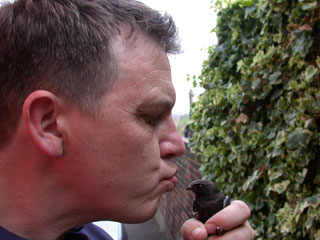
Common Swift: Sheffield, July 2006 Author with Charlie. After 5 weeks of mushed cat food, vitamin supplements and lean mince beef, Charlie took his first ever flight on 2nd August 2006 — and was never seen by us again.
Please note: It is now known that any diet, other than suitable insects, leads to poor outcomes for rehabilitated Swifts. Do not use cat food or minced beef (Fuste 2013).
Acknowledgements
Thanks especially to Ian Lewington for much learning together. To Paul Hackett for his enthusiastic encouragement and photographic skills and to Daniele Occhiato, Tom Lindroos and Dick Newell...your flight shots of Swifts are just amazing! To see more images from Daniele Occhiato see his website at http://www.pbase.com/dophoto/.
References
Cramp and Simmons. 2004 Birds of the Western Palearctic interactive. Published by BirdGuides, Sheffield.
Harvey, W. G. 1982: Pallid Swift in Kent. Birds new to Britain and Ireland. Calton.
Lewington, I. 1999: Separation of Pallid Swift and pekinensis Common Swift. Birding World 12: 450-452.
Preston, M. 1999: The first Pallid Swift to be ringed in Britain. Birding World 12: 448-449.
Thorup, K. 2001: First record of Pallid Swift Apus pallidus in Denmark and of ssp. illyricus in northern Europe. DOFT 95: 169-172.
Vinicombe, K. 2001: Sorting Swifts - late arrivals. Birdwatch 112.
Jonsson, L. 1992: Birds of Europe. Christopher Helm, London.
Svensson, L., Grant, P.J., Mullarney, K., Zetterstrom, D. 1999. Collins Bird Guide. HarperCollins, London.


